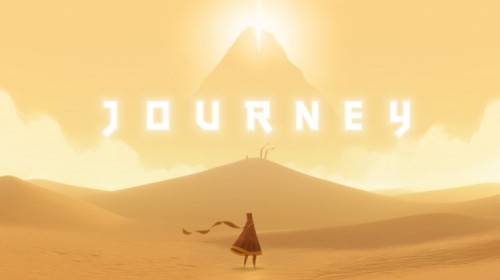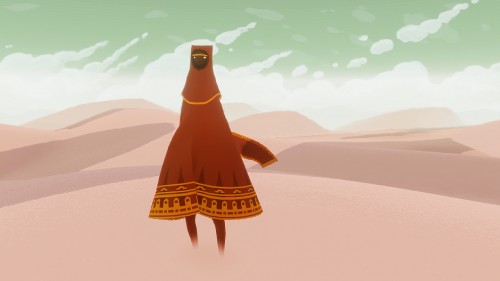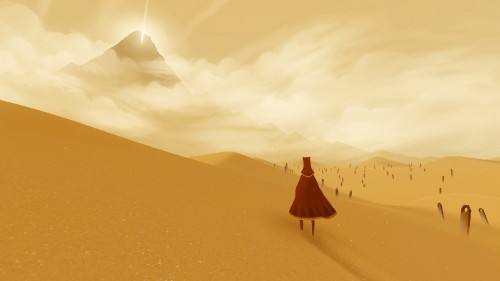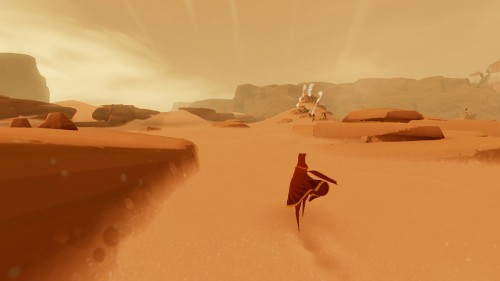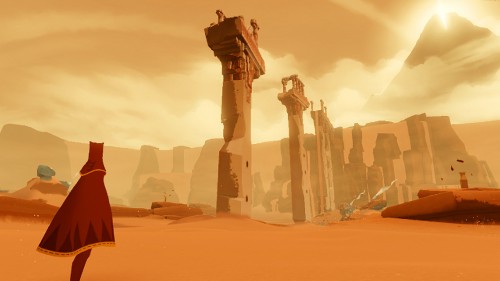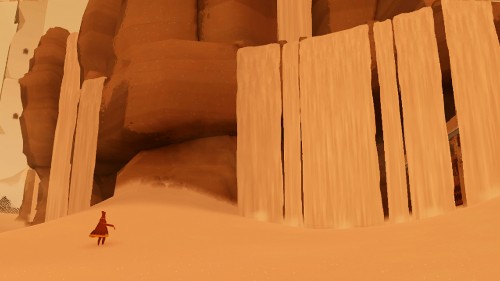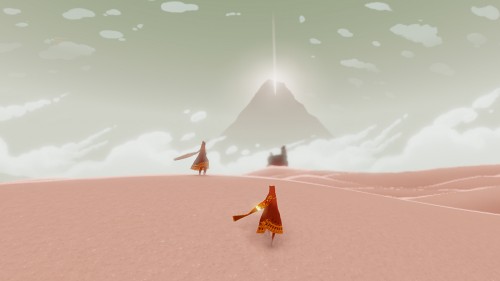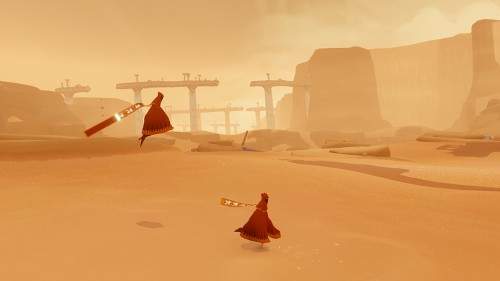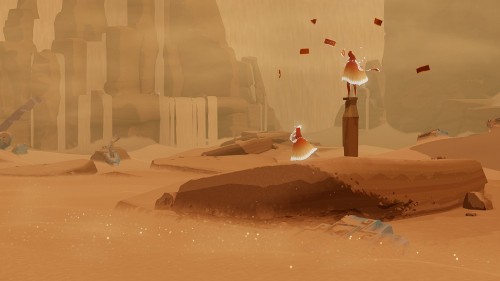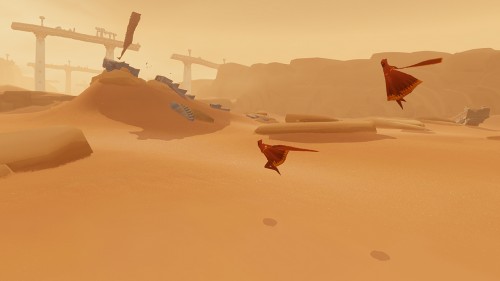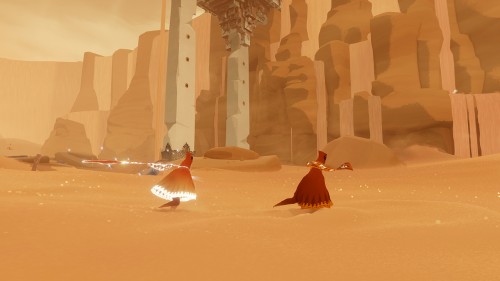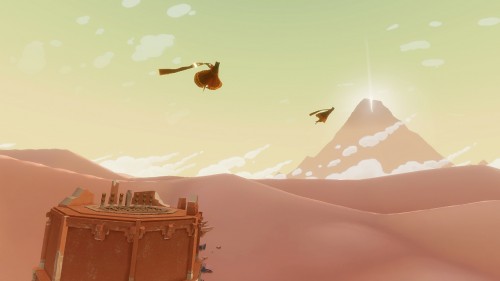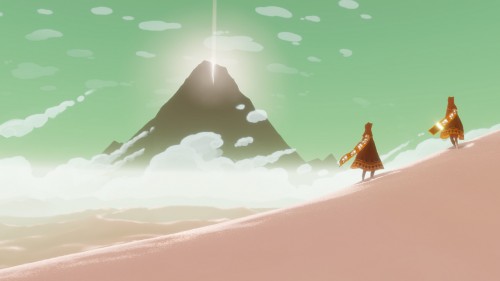Journey. The title of Thatgamecompany’s third game is quite possibly the most fitting title to ever grace the game it is attached to. For you see, that is the best way to even begin to describe Jenova Chen’s latest offering. It is indeed a journey.
The game begins by showing you the character you play, a nameless and genderless – though for the sake of my sanity I deemed the character to be female – traveler, sitting in the sands of a desert. In the near distance there is a rather tall sand dune with three markers at the top of it. After a brief visual tutorial on how to move the traveler with the left analog stick and the camera with the SIXAXIS controls inside the PS3 controller, though you can also control the camera with the right analog stick, you head towards the dune and when you reach the summit, the screen pulls back revealing a massive desert before you.
The goal of your journey also comes into view, a gigantic and enigmatic mountain with a glowing peak beckoning you from the haze of the horizon. At the same time, the only readable text you’ll see until the end credits appears on the screen, “Journey”. From this point, you are free to move about the desert as you see fit, mostly, at least. As you will unfortunately find out, this beautifully rendered desert is a bit of a mirage. It may appear to be endless, but once you reach the boundaries set by the developers, you’ll be knocked back by an incredibly strong gust of wind.
As you walk around this initial desert area, you will come upon sparse ruins, and at the first ruin you learn the other two parts to Journey’s simple gameplay, flying and singing. You fly in Journey thanks to the long, flowing scarf the traveler has around her neck. Pressing and holding the X button will send you into the sky, but you can only fly as long as the scarf is magically charged. This is where singing comes into play, pressing and/or holding the O button near the various bits of randomly placed pieces of cloth found around the world of Journey will recharge your scarf. You can increase the length of your scarf by finding glowing symbols hidden throughout the areas of the game world.
To advance in Journey, you have to find what I’m calling an altar in each of the game’s areas. When you finally get to an altar, you have to sing to all of the markers around it to activate it. Activating an altar will make the traveler sit down and meditate in front of it. During each of the traveler’s meditations, she’ll meet a towering figure wearing a white robe who will reveal a little bit more about the history of the world we are now exploring around in. Visiting altars will also unlock a door behind the altar, which grants you access to the next area of the game.
The music in this game is amazing. Austin Wintory has created a great soundtrack that nearly perfectly fits the tone and setting of Journey. Visually, Journey is something else, and yet again enforces the idea that games are art. Art style wise, there are few games like it. Immediately it will remind you a bit of the excellent Team ICO game Shadow of the Colossus, however as the game advanced, the art began to remind me a bit of Samurai Jack. In addition to the art style, though, there is some impressive tech on display here. If you thought that Naughty Dog created some impressive sand in Uncharted 3: Drake’s Deception, well, I have to say Thatgamecompany has topped even that. The sand in this game is just so organic that it is almost scary at times.
Now you might be wondering, “Wait, isn’t there multiplayer in this game as well? Why haven’t you talked about it yet?” Well, the reason for that, my friends, is because the multiplayer is the best part of Journey, and as they always say, you save the best for last.
Journey’s multiplayer works like this, you only play with one other player at any give time. In other words, you will only see one other traveler on the screen in any given area of the game. You don’t get to see the PSN ID of the other player until after the credits roll, where the game will then list the PSN IDs of all of the players you came across in that particular playthrough. On top of that, you cannot talk to the other player in any way. The only form of communication in Journey is the singing function.
This also helps you identify who you were playing with when you see their PSN IDs, because when you use the singing function, a giant glowing glyph appears over your character, same thing happens when the other player sings, and the thing is the glyphs for the players are different and are random. It is these glyphs that allow you to attach faces to names, so to speak, as they list the glyphs next to their respective PSN IDs. Also, there is no in game option to turn the multiplayer on or off, as long as you are connected to the internet, in other words signed into the PlayStation Network, you will be connected to the multiplayer.
Now how you choose to play the multiplayer is up to you. You can help each other solve puzzles, help show each other where to find the hidden glowing symbols to increase your respective scarves, and help recharge the magic in each other’s scarves by singing to one another, or you can just run off ahead and leave the other player to just do things on their own. If you go through the door to another area without your current traveling companion by your side, however, you will be given another random traveler in the next area instead.
There is one more, rather touching I must say, gameplay aspect to the multiplayer. You can recharge each other’s scarves without singing. If the two players’ characters are close enough to each other, they will both start glowing and recharging. However, this only works if the two travelers are really, really close to each other. In other words, you can recharge each other by huddling together to share body heat.
While Journey is a fun, engaging game in its own right as single player game, what keeps me coming back over and over again to Journey is playing through with other players. My most emotionally invested session of Journey ended with me about to reach the end point by myself, only to turn around and wait for my traveling companion to reach me so we could walk through the end point together, for crying out loud.
Journey is Thatgamecompany’s magnum opus, and is the perfect game for the studio to end their exclusivity contract with Sony with. The game may only last between an hour and a half to 2 hours long, but it is arguably the best hour and half to 2 hours you’ll ever spend playing a video game. If you own a PS3, you owe it to yourself as a gamer to buy this game. Scratch that, if you own a PS3, you owe it to yourself to buy this journey.
Journey retails for $14.99 on the PlayStation Network Store and was released on March 13th, 2012.

